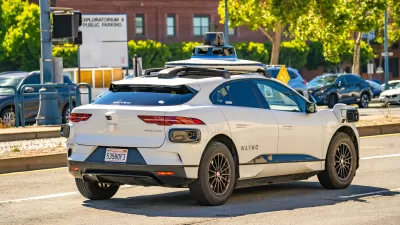A new law will allow police to issue citations to self-driving car operators and create stricter guidelines for crashes and interactions with first responders.

California Governor Gavin Newsom signed a new law that will create guidelines and protocols for autonomous vehicles that are involved in crashes or encounter first responders, reports Andrew J. Hawkins in The Verge.
AB 1777 “would require AV companies to provide a hotline for police to call in case an autonomous vehicle disrupts a crime scene or emergency situation — something that has happened repeatedly in San Francisco.” The bill also gives police the authority to issue “notices of noncompliance” to autonomous vehicles, which were previously exempt under a legal loophole since the law explicitly addresses “drivers.” According to Hawkins, “The citations would not come with any monetary penalties, but if a company racks up enough notices, the DMV could pull their permits.”
Newsom vetoed two other bills related to autonomous vehicles: AB 2286 would have banned self-driving trucks from public roads, while AB 3061 aimed to create more stringent reporting requirements for AV operators. “In vetoing the self-driving truck ban, Newsom noted that the state has already issued draft regulations that offer ‘the nation’s most comprehensive standards for heavy-duty autonomous vehicles.’ These include provisions that would limit driverless trucks from roads with speeds of 50mph or higher and prevent them from carrying certain payloads, like hazardous chemicals.”
FULL STORY: California governor signs one driverless vehicle bill, vetoes two others

Planetizen Federal Action Tracker
A weekly monitor of how Trump’s orders and actions are impacting planners and planning in America.

Map: Where Senate Republicans Want to Sell Your Public Lands
For public land advocates, the Senate Republicans’ proposal to sell millions of acres of public land in the West is “the biggest fight of their careers.”

Restaurant Patios Were a Pandemic Win — Why Were They so Hard to Keep?
Social distancing requirements and changes in travel patterns prompted cities to pilot new uses for street and sidewalk space. Then it got complicated.

California Homeless Arrests, Citations Spike After Ruling
An investigation reveals that anti-homeless actions increased up to 500% after Grants Pass v. Johnson — even in cities claiming no policy change.

Albuquerque Route 66 Motels Become Affordable Housing
A $4 million city fund is incentivizing developers to breathe new life into derelict midcentury motels.

DC Area County Eliminates Bus Fares
Montgomery County joins a growing trend of making transit free.
Urban Design for Planners 1: Software Tools
This six-course series explores essential urban design concepts using open source software and equips planners with the tools they need to participate fully in the urban design process.
Planning for Universal Design
Learn the tools for implementing Universal Design in planning regulations.
Heyer Gruel & Associates PA
JM Goldson LLC
Custer County Colorado
City of Camden Redevelopment Agency
City of Astoria
Transportation Research & Education Center (TREC) at Portland State University
Camden Redevelopment Agency
City of Claremont
Municipality of Princeton (NJ)





























